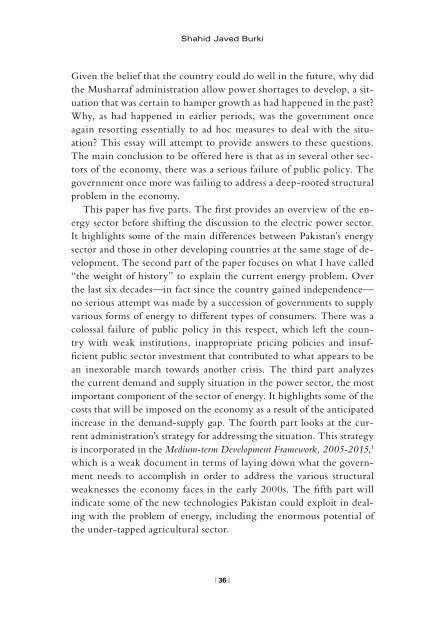fueling the future - Woodrow Wilson International Center for Scholars
fueling the future - Woodrow Wilson International Center for Scholars
fueling the future - Woodrow Wilson International Center for Scholars
- No tags were found...
You also want an ePaper? Increase the reach of your titles
YUMPU automatically turns print PDFs into web optimized ePapers that Google loves.
Shahid Javed BurkiGiven <strong>the</strong> belief that <strong>the</strong> country could do well in <strong>the</strong> <strong>future</strong>, why did<strong>the</strong> Musharraf administration allow power shortages to develop, a situationthat was certain to hamper growth as had happened in <strong>the</strong> past?Why, as had happened in earlier periods, was <strong>the</strong> government onceagain resorting essentially to ad hoc measures to deal with <strong>the</strong> situation?This essay will attempt to provide answers to <strong>the</strong>se questions.The main conclusion to be offered here is that as in several o<strong>the</strong>r sectorsof <strong>the</strong> economy, <strong>the</strong>re was a serious failure of public policy. Thegovernment once more was failing to address a deep-rooted structuralproblem in <strong>the</strong> economy.This paper has five parts. The first provides an overview of <strong>the</strong> energysector be<strong>for</strong>e shifting <strong>the</strong> discussion to <strong>the</strong> electric power sector.It highlights some of <strong>the</strong> main differences between Pakistan’s energysector and those in o<strong>the</strong>r developing countries at <strong>the</strong> same stage of development.The second part of <strong>the</strong> paper focuses on what I have called“<strong>the</strong> weight of history” to explain <strong>the</strong> current energy problem. Over<strong>the</strong> last six decades—in fact since <strong>the</strong> country gained independence—no serious attempt was made by a succession of governments to supplyvarious <strong>for</strong>ms of energy to different types of consumers. There was acolossal failure of public policy in this respect, which left <strong>the</strong> countrywith weak institutions, inappropriate pricing policies and insufficientpublic sector investment that contributed to what appears to bean inexorable march towards ano<strong>the</strong>r crisis. The third part analyzes<strong>the</strong> current demand and supply situation in <strong>the</strong> power sector, <strong>the</strong> mostimportant component of <strong>the</strong> sector of energy. It highlights some of <strong>the</strong>costs that will be imposed on <strong>the</strong> economy as a result of <strong>the</strong> anticipatedincrease in <strong>the</strong> demand-supply gap. The fourth part looks at <strong>the</strong> currentadministration’s strategy <strong>for</strong> addressing <strong>the</strong> situation. This strategyis incorporated in <strong>the</strong> Medium-term Development Framework, 2005-2015, 1which is a weak document in terms of laying down what <strong>the</strong> governmentneeds to accomplish in order to address <strong>the</strong> various structuralweaknesses <strong>the</strong> economy faces in <strong>the</strong> early 2000s. The fifth part willindicate some of <strong>the</strong> new technologies Pakistan could exploit in dealingwith <strong>the</strong> problem of energy, including <strong>the</strong> enormous potential of<strong>the</strong> under-tapped agricultural sector.| 36 |
















